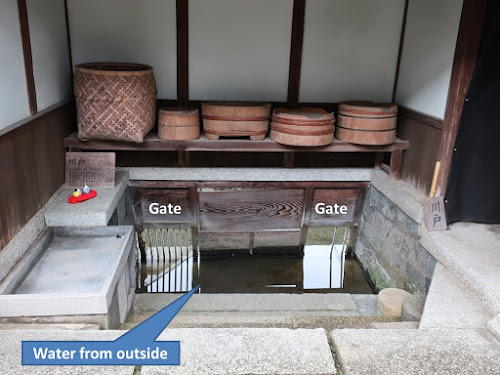Gokasho is located in Ohmi region which is the home town of many entrepreneurs, some of them were the founders of global companies. Gokasho merchants sold mainly fabric, they walked across Japan, and some succeeded. Their huge residences are open to the public. I introduce the residences first.
People in Gokasho, who are thrifty and who work for the society, enjoy working itself. After their success and retirement, they enjoy the golden age like traveling to pray for the prosperity of their family.
The way to the central district “Kondou”.
中心部である金堂の街並みへの入口
This is a private house, although it is as
large as a museum.
一般のお宅も資料館のように広大だ
琵琶湖の東を本拠地とする五個荘商人は呉服や麻布など繊維類を主力商品として、全国を行商し、豪商へと出世していった。彼らの豪勢な屋敷が公開されている。近江商人博物館は残念ながら撮影禁止だが、四つの旧家で博物館の内容に匹敵する展示がしてある。旧家からご紹介する。
質素倹約を旨とし、世間のために商いをしていくという彼らは、仕事自体に楽しみを感じているようだ。でも、財をなして隠居した後は、家の繁栄を願う旅などを楽しんだ。
Museums (former merchant houses) are on this
alley.
資料館として公開されている商人屋敷がある小路
Boards of ships are attached to the walls of warehouses. Those are
water-proof and they make walls durable. R. Shiba (famous novelist) praised the town
and wrote,
“There are many enormous mansions. They have fire-proof storehouses;
ship boards cover the white walls. --- Each building doesn’t have any
atmosphere of vulgar millionaires; it follows a genuine traditional “Sukiya”
style. Moreover, each building has its agreeable individuality.” I totally
agree with him. They are huge buildings but they exude the spirit of
simplicity and fortitude (Shitsujitsu-Gouken).
船板を蔵に貼って漆喰の耐久性を上げる。司馬遼太郎が「街道をゆく」の中で、
「船板塀をめぐらし、白壁の土蔵をあちこちに配置して、とほうもなく広壮な大屋敷ばかりである。(中略)どの家のつくりも成金趣味が、かけらもなくどれもが数寄屋普請の正統を、いちぶもはずさず、しかもそれぞれ好もしい個性があった。」と激賞している。その通りだ。広大だが、質実剛健を感じる作りだ。Uhei Tonomura's house、外村宇兵衛邸
Tonomura family succeeded in the sale of
textiles. The gate isn't luxurious.
外村家は江戸後期に呉服で豪商になった。門構えは華美ではない
Inside the gate, there is “Kawato”, which gathers water from outside. They washed vegetables and they could also keep
fishes there. The water is clean, and people didn’t pollute it too much.
門を入ると外の水路から水を取り入れる川戸がある。野菜などの洗い場であり、魚も飼えるという。まず、水が綺麗だし、綺麗に使っている。
The entrance is very simple. 玄関は至って簡素だ
玄関を入ると土間があり、奥の台所、便所へを続く。
There are many rooms like above one on the
right side of the earthen floor. It is a large space.
By the way, we celebrate the Girls’ Day on
the 3rd of March. It is called “Hina Matsuri (festival)". I visited in
February, so luxurious Hina dolls (left) are exhibited already.
土間の右側は広大な居間になっており、このような座敷が続く
The decoration above is called "Goten(palace)-hina(Hina dolls); So luxurious!
2月に訪問したので、座敷には豪華な御殿雛も飾られていた。
 |
Success history of this family is shown in
the storehouse which connects to the residence.
家と直結している蔵には、成功に至るまでの数々の品が展示してある
|
 |
The family sold Japanese textiles at
first, then expanded to western ones; the brand is “Miyuki”.
呉服商から洋服に展開し、御幸毛織になっている。親会社の東洋紡も近江商人の流れを汲む。
|
 |
They have used the double-entry
bookkeeping system since the Edo period (1603—1868). Their account book and abacus (calculator)
are exhibited.
帳場の横には、帳簿とそろばんが置かれている。近江商人は、古くから独自の複式簿記を使っていた。
|
Ohmi merchant、近江商人について
 |
| Ohmi merchants、行商する近江商人 |
 |
These are merchant gears; a bill holder, a
safe and so on. They travelled with these.
商人が持ち歩いた手形・証文挟みや銭箱、提灯。雨の日も歩くし、大変な出張だ
|
Reference: Museums in Ohmi-hachiman 近江八幡の資料館
 |
Business tools of Oumi merchants including
Gokasho
近江商人・五個荘商人と商売道具
|
Life of the merchant、商家の暮らし
The main livelihood of Gokasho merchants was agriculture, so their
lives were self-sufficient basically; they made vegetables, chickens, silk,
canola oil and so on. It was a thrifty life.
By the way, we have particular time which is called “Hare”; it is
the time when festivals, annual events and wedding ceremonies are held. On the “Hare”
day, they spent luxurious time. They ordered excellent ingredients from
shops in Kyoto, and hired a chef in order to make a feast. (The information
below contains info from Ohmi merchant museum.)
五個荘の商人は農業を本にしており、野菜、鶏、生糸、菜種油など原則的に自給自足の質素な生活をしている。しかし、ハレの日には、京都から山海の珍味を取り寄せ、料理人を雇って豪華な振る舞いをしたということだ。(写真は外村宇兵衛邸の展示品、近江商人博物館のパネル記載情報も追記)
 |
While the husband went out for business,
the wife managed the home. Children studied hard to succeed.
男達の行商の間、妻が家を守ることになる。子ども達は勉学に励む。
|
After success and retirement, their activities were,
1. Social activities, for example, investment to the public works
2. Cultural activities, for example, teaching at the Terakoya school, creating poems or
pictures.
3. Religious activities, for example, donating to the shrines or the temples, visiting the
shrines or temples and praying for his ancestors and prosperity of his family.
It is really golden age! I’m sure their
journey was totally different from the business trip.
成功した後は隠居となり、
①公共事業への投資など社会活動、
②寺子屋で教えたり、俳諧・絵画を楽しんだりの文化活動、
③神社仏閣への寄進、笈を背負っての霊場巡りの宗教活動。先祖の供養と店の発展を祈願して歩くという。
ここまでくれば、夢のような生活だ。退職後を英語で、ゴールデン・エイジとも言うがその通りだ。旅はさんざんしてきた彼らだが、商売で旅するのと参詣で旅をするのでは心持ちが全く違ったと思う。①公共事業への投資など社会活動、
②寺子屋で教えたり、俳諧・絵画を楽しんだりの文化活動、
③神社仏閣への寄進、笈を背負っての霊場巡りの宗教活動。先祖の供養と店の発展を祈願して歩くという。
Each family has its own precepts, but all of them require to work
hard for the customers and the society, not to pursue only the profit.
It is unclear why many merchants and entrepreneurs were born in Ohmi
region, but I think;
First of all, their traditional mantra
(values, mission) supported merchants strongly to overcome difficulties of
their business. Secondly, there were many cases of success in Ohmi which
inspired the younger generation to do likewise.
各家の家訓に共通するのは、目先の利益だけに走らず、お客様のため、また、世間のために懸命に働くことを求めていることである。
近江がたくさんの商人を生んだ理由は諸説あるが、明確ではないと言うことだ。私は、①世間のために働くという明確な価値観・ミッションがあったので、苦労を乗り越えられたこと、②身近に成功例がありチャレンジしやすかったこと、だと思った。
売り手によし、買い手によし、世間によしの「三方良し」は、近江商人の価値観に基づく昭和生まれの言葉であることを初めて知った。
 |
Gokasho town from the second floor、二階から見た五個荘の街
|
Website:
http://www.city.higashiomi.shiga.jp.e.ri.hp.transer.com/0000000104.html
https://www.city.higashiomi.shiga.jp/0000000104.html (in Japanese)
accessed in March, 2020
Shigeru Tonomura's house、外村繁文学館
 |
This is the extended family house of U.
Tonomura. The gate is also simple.
外村宇兵衛家の分家になる。入口はやはり質素だ。
|
 |
The approach from the gate to the entrance
is simple and neat.
門を入って玄関までもやはり質素で小ぎれいなアプローチだ
|
 |
Many Hina dolls were decorated on the
tatami floor mats.
座敷にはお雛様が沢山飾られていた。華やかです。
|
 |
Kitchen is large and has a lot of kitchen-ware.
Many of them were used on the Hare day.
玄関の奥の台所。ハレの日備えて、沢山の厨房機器がある。
|
 |
A unique water supply system is equipped. The
water is delivered to the bathtub by the syphon tube.
井戸でくみ上げた水を、サイフォンで風呂に供給する配管が仕込まれいる。
|
These are precepts for the wife in the kitchen. It is obsolete now, but it is a good lesson.
- Take a back seat to the husband
- Offer the rice to the family altar every morning and evening
- Never waste rice even if it is only one grain
- Wash underwear by yourself (don’t order the maid to wash; it is a manner)
- Don’t lecture maids in the morning
- Warm sake (alcohol) to the proper temperature ("proper" is important always)
台所に貼ってあった妻女の心得、古くさいと言えばそれまでだけど、家を平穏に続けていくコツだと思います。
 |
Shigeru Tonomura’s study room; he was an author
who was born and raised in this house. Snow viewing sliding doors are
excellent.
当家で育った明治生まれの作家・外村繁の書斎。雪見障子が上品だ
|
 |
Large glass windows are set in the
snow viewing sliding doors of the guest room (zashiki).
座敷の雪見障子には大きなガラス窓が使われている
|
 |
| 2nd floor、二階の座敷 |
Website:
http://www.city.higashiomi.shiga.jp.e.ri.hp.transer.com/0000000106.html
https://www.city.higashiomi.shiga.jp/0000000106.html (in Japanese)
accessed in March, 2020
Three funs(楽fun)were found. Visited in February, 2020
Previous post (Museums in the Ohmi merchant town):
Museums in Ohmi-hachiman 近江八幡の資料館
Next post (Part2 of this town):
Museums inOhmi Gokasho (2)、近江・五個荘の資料館(2)

















Comments
Post a Comment